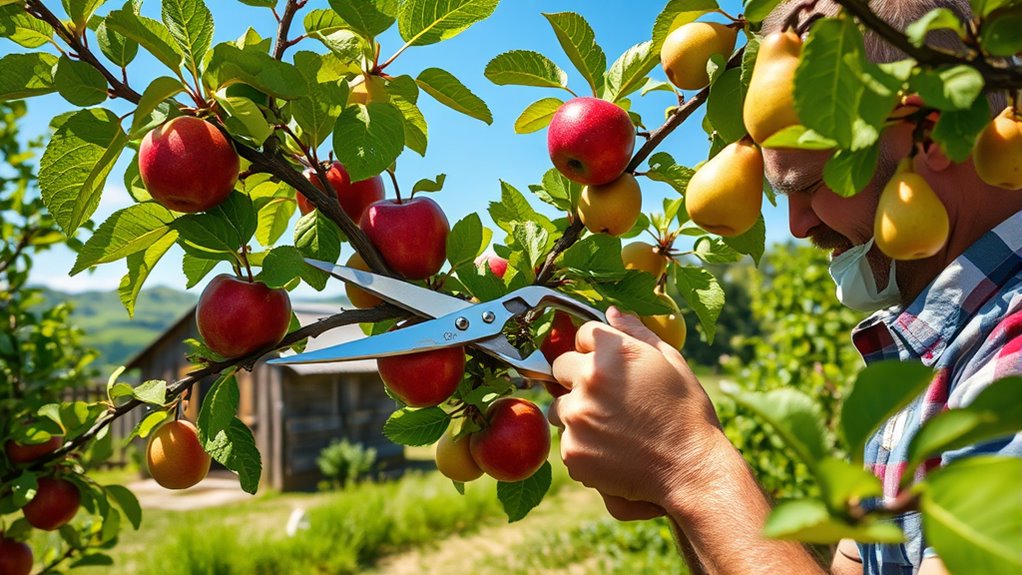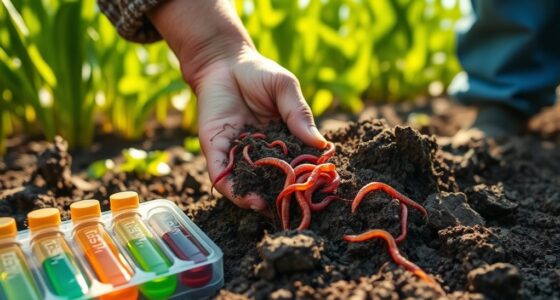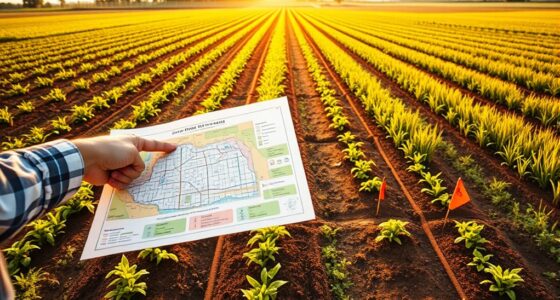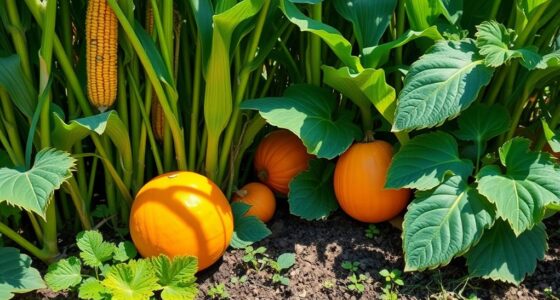To successfully plant and prune fruit trees on your homestead, start by testing and amending your soil to make certain of healthy roots and strong growth. Plant trees at the right depth, with roots spread out evenly, and prune during dormancy to remove dead or diseased branches, improve airflow, and support fruit production. Regular care and proper techniques promote healthier trees with better yields, so keep exploring to learn more about creating thriving, fruitful trees on your property.
Key Takeaways
- Test and amend soil pH and nutrients to create a healthy foundation for planting fruit trees.
- Plant trees with roots spread evenly, ensuring the graft union sits just above soil level for proper growth.
- Prune during dormancy to remove dead or diseased branches and improve air circulation and sunlight exposure.
- Sterilize pruning tools after each cut to prevent disease spread and promote healthy healing.
- Regularly inspect and maintain trees to support strong branches, enhance fruit quality, and ensure long-term vitality.

Planting and pruning fruit trees are indispensable steps to guarantee healthy growth and abundant harvests. When you’re ready to introduce new trees to your homestead, focus first on proper soil preparation. Healthy soil provides the foundation for vigorous growth, so you should test your soil’s pH and nutrient levels beforehand. If it’s too acidic or alkaline, amend it with organic matter such as compost or aged manure. Well-prepared soil ensures your trees develop strong roots, which are essential for disease prevention. A healthy root system helps trees resist pests and infections, reducing the need for chemical treatments. When planting, dig a wide enough hole so the roots can spread comfortably, and avoid planting too deep—make sure the graft union sits just above the soil line. Spreading roots evenly in the prepared soil promotes stability and nutrient uptake, supporting overall health.
Once your trees are established, pruning becomes fundamental for maintaining their vigor and productivity. Pruning also plays a key role in disease prevention by removing dead, diseased, or damaged branches that can harbor pests or pathogens. When you prune, focus on opening up the canopy to improve air circulation and sunlight penetration. This reduces moisture buildup, which is a common catalyst for fungal diseases like blight or mold. Use sharp, clean tools to make precise cuts, which helps prevent the spread of infections. Remember to prune at the right time, typically during dormancy in winter, so the tree can recover quickly and focus energy on new growth in spring. Proper pruning encourages the development of strong scaffold branches that support fruit loads, reducing the risk of branch breakage and disease entry points. Additionally, employing proper pruning techniques can enhance fruit quality and yield.
Throughout the process, always keep disease prevention in mind. Regularly inspect your trees for signs of pests or infections, and prune out affected areas immediately to stop the spread. Maintain good hygiene by sterilizing your tools after each cut, especially when dealing with diseased wood. Combining soil preparation with strategic pruning creates a healthier environment for your fruit trees, leading to fewer problems and higher yields. By diligently preparing your soil and pruning thoughtfully, you set your trees up for a long, productive life on your homestead. These practices not only promote disease resistance but also guarantee that your fruit trees remain vigorous and fruitful for years to come.
Frequently Asked Questions
How Do I Select the Best Fruit Tree Varieties for My Climate?
To select the best fruit tree varieties for your climate, start by understanding your climate zone. Research tree variety selection options that thrive in your zone’s temperature, rainfall, and frost dates. Talk to local nurseries or extension offices for recommendations. Choose varieties known for resilience and good yields in your area. This way, you guarantee your trees will grow healthy and produce fruit reliably, regardless of your specific climate conditions.
What Soil Amendments Improve Fruit Tree Growth and Fruit Quality?
To improve your fruit tree growth and fruit quality, focus on soil amendments like compost application, which boosts nutrient levels and enhances soil structure. Additionally, monitor and adjust soil pH as needed, since ideal pH levels vary by fruit type. These steps guarantee your trees get the nutrients they need and thrive, resulting in healthier growth and tastier, more abundant fruit.
How Often Should I Fertilize My Fruit Trees for Optimal Production?
You should fertilize your fruit trees based on soil testing results, typically every 4 to 6 weeks during the growing season. Use organic fertilizers to provide essential nutrients naturally. Regular fertilization encourages healthy growth and ideal fruit production. Adjust your schedule if your soil tests show deficiencies, and reduce fertilization as the trees mature or during dormancy. Consistent feeding ensures your trees stay vigorous and produce high-quality fruit.
When Is the Best Time to Prune Different Types of Fruit Trees?
Many believe pruning timing is universal, but timing considerations vary by tree type. You should prune deciduous fruit trees like apples and cherries in late winter when they’re dormant, ensuring healthy growth. Stone fruits like peaches benefit from pruning after harvest, while citrus trees are best pruned in early spring. Use proper pruning techniques to promote airflow and fruit production, understanding each tree’s unique growth cycle for ideal results.
How Can I Protect Young Trees From Pests and Diseases?
To protect young trees from pests and diseases, start with pest-resistant varieties suited for your area. Use organic pest control methods like neem oil or insecticidal soap to keep pests at bay without harming beneficial insects. Regularly inspect your trees for early signs of trouble, remove affected parts promptly, and maintain good sanitation. These steps help make certain your young trees stay healthy and thrive naturally.
Conclusion
By planting and pruning your fruit trees carefully, you’re nurturing a future orchard that will flourish like a well-tended garden of dreams. Remember, each cut and every new sapling is a step toward bountiful harvests and sweet, juicy rewards. With patience and love, you’ll watch your trees grow strong and fruitful, transforming your homestead into a vibrant oasis of abundance. Keep tending, and soon you’ll reap the wonderful bounty you’ve cultivated with your own hands.










